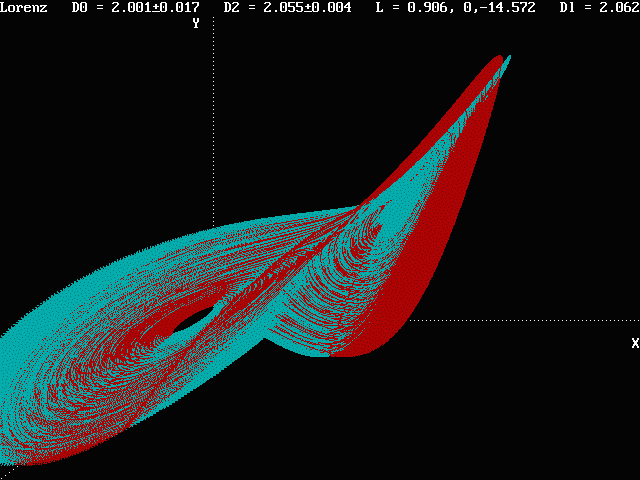
The Lorenz attractor is given by the following 3-dimensional system of ordinary differential equations:
dx/dt = p(y - x)
dy/dt = -xz + rx - y
dz/dt = xy - bz
In his orginal paper [E. N. Lorenz, J. Atmos. Sci. 20, 130 (1963)], Lorenz used the parameters p = 10, r = 28, and b = 8/3 for which the trajectories produce a strange attractor.
For reasons unknown, published calculations of the largest Lyapunov exponent for the Lorenz attractor [see for example, A. Wolf, J. B. Swift, H. L. Swinney, and J. A. Vasano, Physica 16D, 285 (1985)] have usually used the values p = 16, r = 45.92, and b = 4 for which the Lyapunov exponents (base-2) are (2.16, 0, -32.4). It is more natural to express the exponents for a flow in base-e, in which case the values are (1.50, 0, -22.46). For a flow, one of the exponents must be zero and the sum of the exponents is -p - 1 - b = -21, which is approximately satisfied by the quoted results.
Reported here is a numerical calculation of the largest Lyapunov exponent for the Lorenz attractor using Lorenz's original parameters. The calculation was performed in a several-day run on a 200-MHz Pentium Pro using a PowerBASIC program available in both source and (DOS) executable code. The program uses the fourth-order Runge-Kutta method with a fixed step size of 0.001, and performed over 109 iterations, corresponding to a maximum time of over 106. More details on the numerical calculation of the Lyapunov exponent are available. Output from the program is shown below:

The image above shows the Lorenz attractor as an
anaglyph that can be viewed in 3-D using red-blue glasses . The
values
of the Lyapunov exponents are (0.906, 0, -14.572). From
these
exponents, the Kaplan-Yorke dimension can be calculated from
DKY
= 2 + l1 / |l3|
= 2.062. The program also calculates the capacity dimension D0
= 2.001 ± 0.017 and the correlation dimension D2
= 2.055 ± 0.004, but these values are considerably less
reliable
than the Kaplan-Yorke dimension, which is believed to be accurate to
the
four significant digits quoted. In particular, it is known that D0
cannot be less than D2. In addition to the
statistical
errors quoted above, there are systematic errors particularly in the
calculation
of D0 arising from the rather crude box size of 100
x
100 x 100 used in the capacity dimension calculation.
. The
values
of the Lyapunov exponents are (0.906, 0, -14.572). From
these
exponents, the Kaplan-Yorke dimension can be calculated from
DKY
= 2 + l1 / |l3|
= 2.062. The program also calculates the capacity dimension D0
= 2.001 ± 0.017 and the correlation dimension D2
= 2.055 ± 0.004, but these values are considerably less
reliable
than the Kaplan-Yorke dimension, which is believed to be accurate to
the
four significant digits quoted. In particular, it is known that D0
cannot be less than D2. In addition to the
statistical
errors quoted above, there are systematic errors particularly in the
calculation
of D0 arising from the rather crude box size of 100
x
100 x 100 used in the capacity dimension calculation.
For a more recent and more accurate calculation see the Lyapunov
Exponent Spectrum Software.